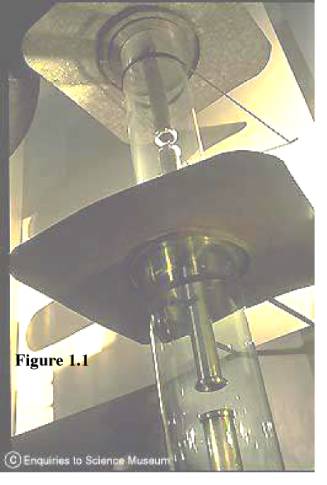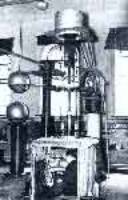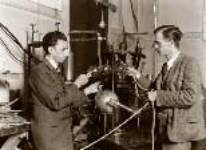|
Fermilab has the most powerful accelerator in the world. This process of particle acceleration begins with a small bottle of hydrogen located in the electrostatic Preaccelerator, which is where everything starts. Fermilab's Preaccelerator is based on the Cockcroft-Walton design. It produces H- ions (hydrogen consists of a proton and an electron. The H- ion has an extra electron added) with an energy level of 750 keV (1 eV = one electron volt). The H- ions travel through the Linac and enter the Booster where both electrons are stripped off leaving a proton.
Accelerator History
In May of 1928 the young Irish Physicist, Ernest Walton, had been trying to produce "fast electrons" for transmutation research. But he realized that the accelerating method he was using to create these fast electrons wasn't going to work. The problem was with the electron's mass, which was small and required very high voltages to contain and control. He proposed to Sir Ernest Rutherford, then head of Cambridge University's Cavendish Laboratory, a method of accelerating the positively charged proton. The proton's high mass eased the need for high voltages at high frequencies.
John Cockcroft had also proposed using protons as a means of disintegration. The two men, pictured on the right, joined forces. Walton built most of the high voltage and accelerator apparatus while Cockcroft solved many of Walton's engineering problems. The picture above and to the left shows Cockcroft and Walton’s original accelerator. It's an eight-foot glass tube under vacuum and they used a voltage multiplier to generate a potential of about 800 kilovolts. The protons themselves were accelerated to an energy level of a few hundred kilovolts (keV). At the end of the tube they placed a fixed lithium target, which they bombarded with the protons. They found that when a lithium nucleus disintegrated, it split into two alpha particles.
The Cockcroft-Walton design, completed at Cavendish in 1932, was the first linear accelerator. Their work on the transmutation of lithium was the initial verification of Einstein's law concerning the equivalence of mass and Energy, E=mc 2, and also of Gamow's tunneling theory.
The larger machines of the 1950s and 60s and high-energy physics done at Fermilab and other physics labs around the world, are a direct result of the fundamental research performed by John Cockcroft and Earnest Walton. Rutherford said, "it’s the first step that counts" and this was a huge first step.
The drawing below is an original diagram of the Cockcroft-Walton accelerator, Cavendish Laboratory, Cambridge, c. 1932. But the accelerator was not the only significant achievement; the high voltage multiplier was just as important.
In 1951, during Professor I. Waller's presentation of the Nobel Prize in Physics to Sir John Cockcroft, Waller said:
The work Cockcroft and Walton was a bold thrust forward into a new domain of research. Great difficulties had to be overcome before they were able to achieve their first successful experiments at the beginning of 1932. By then, they had constructed an apparatus, which, by multiplication and rectification of the voltage from a transformer, could produce a nearly constant voltage of about six hundred thousand volts. They had also constructed a discharge tube in which hydrogen nuclei were accelerated. Causing these particles to strike a lithium layer, Cockcroft and Walton observed that helium nuclei were emitted from lithium. Their interpretation of this phenomenon was that a lithium nucleus into which a hydrogen nucleus has penetrated breaks up into two helium nuclei, which are emitted with high energy, in nearly opposite directions. This interpretation was later fully confirmed.
Thus, for the first time, a nuclear transmutation was produced by means entirely under human control.
Accelerator Update Archive

|



